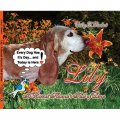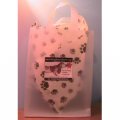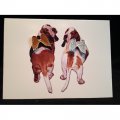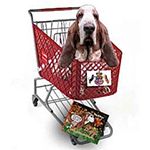Glossary – Ophthalmologic terms – Canines
GLOSSARY – OPHTHALMOLOGIC TERMS FOR CANINES
I am in the process of setting up a glossary of ophthalmologic terms for everyone’s reference. Basset hounds are pre-disposed as a breed to glaucoma. This is one reason you are going to a reputable breeder, to decrease your chances of this insidious disease.
Please read this prior to buying a basset pup from a reputable breeder. I say reputable, because this is the only way you should buy a basset hound puppy. This page has nothing to do with buying from a rescue,
which I totally endorse via my rescue links page.
It also has nothing to do with buying from a pet store or back yard breeder which you should NEVER do! But if you did I am still here to help with you with your Glaucoma questions.
Medical Disclaimer
Medical informationobtained from my website is not intended as a substitute for professionalcare. If your hound has or if you suspect your hound has a problem, you shouldconsult your vet or emergency vet ASAP. Glaucoma is an emergency and should be treated as such.
Glaucoma can often be felt by your pet as an intense headache and is believed to be more painful in dogs than it is in people, however, the symptoms are often difficult to recognize. Their discomfort may hide itself within their behavior, including a loss of appetite, disinterest in play or simply irritability. You can also look for changes in behavior, general vision loss, cloudy eyes, dilated pupils, increased tearing or red, bloodshot eyes. Sensitivity to light as observed by squinting, or, eye pain as seen by the dog rubbing on it’s eyes may also be a sign of developing Glaucoma in your pet’s eye. Once severe levels are reached, glaucoma can result in large, bulging eyes, but, by the time this symptom is seen it is often too late to save your dog’s vision in that eye. In other words, the earlier the glaucoma is diagnosed, the better the outlook for your pet’s vision.
That said, when your hound starts to go blind, or suddenly becomes blind I want you to have a place to go and look up what I think is necessary.
FIRST OFF……DON’T PANIC THIS WILL NOT HELP YOU OR YOUR HOUND.
THEN LOCATE AN OPHTHALMOLOGIST IN YOUR AREA, CLICK HERE!
I am sure you will google all of this, just like I did, and these sites and words are what I found to be the most helpful. I have also been through it and can offer quick and sound advise. Make sure you go to Emma’s blog and read from the bottom up. She will give you tips and hope. You can e-mail me any of your questions. I will do my best to help you along your way. It is scary! Many people will tell you how well bassets do blind. They do. However, it does not make us feel any better. I feel your pain! There is a huge human factor. Your hound may do better than you, but I feel for you. We are in it together. Let’s hold paws and march into life’s unknown. We love you! Keep in mind that we are here for you. We grieve with you! We know how you feel!
I will also be adding the names of the myriad of drops and medications that you may be prescribed in an effort to save vision in your hound’s eyes. They are expensive and the regiment can be complicated. I am adding these medications names under:
Medications (scroll down to M)
A lot of Veterinary Specialists websites state that it is very hard to catch glaucoma in the first eye. I think I could have done just that had I been alerted by my breeder that Emma’s abnormal drainage angles were a cause of concern.
According to my doctors, I should have been getting her pressures checked every three months based upon her initial eye examination (gonioscopy) as a pup. She was diagnosed with bilateral abnormal drainage angles from birth. This genetic diagnosis pre-disposed her to hereditary, closed angle, primary glaucoma. I was never told this from her breeder. I was told that this did not make a difference. Emma started going blind at age 2. This did make a difference.
So, here is your chance to know more. Knowledge is power and power can mean vision for your hound, if not forever, for a longer period of time!
Here are the terms. There will be additions as well as updates continually.
A
ANGLES
Also known as drainage angles: To understand glaucoma, it is necessary to understand how the fluid inside the eye normally flows and maintains normal intraocular pressure. Fluid inside the eye (aqueous humor) is produced behind the colored area of the eye (iris) in a portion of the eye called the ciliary body. This aqueous humor is made by filtering blood. The fluid flows through the dark hole in the eye (pupil). Finally, the aqueous humor drains from the eye at the junction of the clear cornea and the colored iris (drainage angle) inside the eye and then the aqueous rejoins the blood.
The drainage angle is a sieve-like network. This aqueous humor is made inside the eye and passes from the eye at the same rate. This results in a stable intraocular pressure of 15-20 mm of Hg. Glaucoma is the consequence of a blockage of the outflow of aqueous humor and a subsequent build-up of pressure inside the eye. The resulting high pressure compresses the optic nerve and results in loss of vision and pain with enlargement of the eye.
Also known as eye removal.
I am researching other sites for more canine information about this word. Here is one I found helpful:
ANSWERING YOUR QUESTIONS ABOUT ENUCLEATION
I am also going to interview my vet and hopefully have a mini video lecture for you. He is really good at this procedure.
G
GLAUCOMA IN THE BASSET HOUND
THIS ARTICLE IS OLD, BUT STILL RELEVANT. I BELIEVE THERE IS A NEW STUDY GOING ON AT THE AKC LEVEL THAT I WILL RESEARCH AND REPORT ON – CAT
by John S. Sleasman, DVM
Tally-Ho: May/June 1975
Glaucoma, by definition, is an increase in pressure within the eye. Glaucoma, or ocular hypertension, may be a result of excessive fluid production or inadequate drainage of fluid from the inner eye. This ocular disease is categorized as primary or secondary glaucoma. Primary glaucoma is considered to be that condition that cannot be attributed to any definite lesion within the eye. Secondary glaucoma arises from specific eye disease.
Certain parts of the eye are particularly important in understanding glaucoma. These structures are in the anterior segment of the eye, and include the iris and ciliary body, the anterior and posterior chambers, the filtration angle, and the intrascleral drainage plexus. The iris (the pigmented tissue surrounding the pupil) divides the fluid cavity of the eye into an anterior and posterior chamber. The ciliary body located where the iris attaches, secretes aqueous humor or the inner fluid of the rye. This fluid fills the anterior and posterior chambers of the eye and drains through the titration angle, past the Pectinate Ligaments (Trabecula) into a series of vessels called the Intrascleral Plexus. It is the Pectinate Ligaments (Trabecula) that are important in basset hound glaucoma. Excessive thickening of these ligaments blocks the drainage of fluid from the eye which leads to glaucoma.
Causes of glaucoma can be genetic or acquired, such as infections or trauma, and some may be a combination of genetic predisposition and a concurrent acquired eye disease. I believe adult basset hounds that develop glaucoma have a genetic defect in the filtration angle and when injury or inflammation occurs in the eye, the marginal drainage in existence is further embarrassed, resulting in an inability of the fluid to drain from the eye.
There are many general characteristics of glaucoma, all of which are not usually exhibited in any one animal. A great deal depends upon the nature of the attack, whether it falls into primary or secondary classification, and length of time glaucoma is present before detection. The general characteristics include: (1) increase in intraocular pressure; (2) pain: (3) cloudy or “steamy” surface of the eye; (4) insensitive surface of the cornea: (5) narrowed distance between cornea and iris; (6) dilated pupil; (7) enlargement of the eye; (8) loss of vision, complete or partial, due to damage to nerve tissue in the back of the eye; (9) corneal changes due to exposure and drying of the cornea.
The diagnosis of glaucoma as established by evaluating the clinical signs described and measuring the inner pressure of the eye. The pressure is determined by the use of an instrument called a tonometer. There are several different tonometers but all basically measure how far the cornea indents when a certain weight is placed on the surface of the eye. The diagnosis of glaucoma can be difficult because other eye conditions can mimic several of the signs of glaucoma.
The treatments for glaucoma are as varied as the causes. The treatment must be tailored to the type of glaucoma. The means of treating glaucoma are medical and surgical approaches or a combination of both. It has been my experience that the medical approach to glaucoma is seldom satisfactory. Most owners are reluctant to assume the responsibility of daily care and observation necessary over the life of the animal. Drugs usually fail to prevent blindness. Because of this, I usually prefer a surgical approach in nearly all cases of glaucoma. In some cases drugs are used presurgically to reduce the pressure and in others to help control pressure post-surgically. Many animals progressively lose their vision regardless of treatment. In many cases, the treatment can be considered a success if the eye is painless and need not be removed. For the above reasons and because of the genetic implications of glaucoma, a diagnosis must be established early in the course of the disease and those animals treated and eliminated from breeding programs.
Studies indicate glaucoma in the basset may be a primary glaucoma due to genetic factors. Some investigators feel that luxated or “slipped” lenses are the cause of the glaucoma because many bassets with the disease have luxated lens. I believe the luxated lens is secondary to the glaucoma.
I agree with the group of investigators who believe the cause of glaucoma in the basset hound is due to a congenital, hereditary defect in the angle of the eye. This defect consists of a sheet of tissue in the angle that decreases the flow of fluid out of the eye. This sheet of tissue is complete in some areas of the circumference of the eye and in other areas has “flow holes” present. Some basset hounds have only a trace of this tissue and others have almost no areas for fluids to flow out of the eye. There are some bassets that show no evidence of this tissue. The finding of abnormal angles in closely related dogs with glaucoma indicates possible genetic factors. In a survey I was involved with, several basset hounds were examined. A high percentage showed varying degrees of abnormal angle development.
Unfortunately, the elimination of glaucoma in the basset hound will be difficult at best. The apparent recessive nature of the disease is likely to cause the incidence of glaucoma in the basset hound to increase. These are a few suggestions that may help to control this disease: (1) be certain any basset hound with an eye problem is examined by a veterinarian (2) if a significant number of cases of glaucoma are detected in a kennel, a veterinary ophthalmologist should be consulted. He will be able to examine the filtration angle of breeding animals and possibly make suggestions concerning future breedings. Glaucoma in the basset hound can only be understood and controlled by cooperation between breeders and researchers.
Here is another good article.
Getting the Drop on Glaucoma: The Medical and Surgical Management of Glaucoma
Robert J. Munger, D.V.M., D.A.C.V.O.
Animal Ophthalmology Clinic
Dallas, Texas
Reputable breeders of breeds that are pre-disposed for glaucoma (bassets being one of them) have this test performed on every pup in every litter. This is done so the reputable breeder does not breed a pup that has abnormal drainage angles. They also should not sell a show quality pup to another potential reputable breeder without this CERF documentation that insures an additional safe guard towards that pup not having glaucoma.
(Do not buy a companion pup from a breeder with abnormal drainage angles. This is your paw up on knowing what to do.)
A special mirrored contact lens is used to allow the doctor to examine the structures in the front of the eye. With this lens, the doctor can assess the eye’s drainage system.
Make sure you ask your breeder if they do this test. It is expensive and necessary for reputable breeders at the top level of their profession.
They should disclose all possible inherent diseases to you prior to purchase. Then you can decide how to proceed. Always ask to see the CERT report. You do not want a pup from a breeder that is pre-disposed to glaucoma with abnormal drainage angles. This is a disaster waiting to happen. It is not only an agony for your family, but it is very EXPENSIVE!
This is not the time to be shy. Refer the breeder to my website if necessary. Do not, for any reason, buy a pup with abnormal drainage angles. You are not attached at this point. Go to the next reputable breeder on your list. Your research will pay off! Mistakes can be very costly. You can alway contact the BHCA and ask for their advise. These are the experts.
M – (INCLUDES the word MEDICATIONS, All medications will be in alpha order below the word medications with a *) All other M words will be in order above and below the word medications.
Medications – IN ALPHABETICAL ORDER
is used in the eye as a treatment for glaucoma. Contains 2% dorzolamide, a carbonic anhydrase inhibitor, which decreases pressure in the eye. May also be used to prevent glaucoma in one eye when it is present in the other. Convenient dropper bottle. May sting upon application.
* Xalatan: – MUST BE REFRIGERATED –

This is the medication that is needed on an emergency basis. After Emma had been diagnosed with primary, closed angle glaucoma in her left eye and lost her eye, her eye doctor had a prescription for this in her emergency package for her right eye to try and save it in an emergency situation. The emergency will be an increase pressure in the sighted eye, and the hound will go blind without emergency actions.
This drop might unblock the drainage angle. It is URGENT that you follow instructions.
It is very expensive and runs about 80.00 per very small container. If you have this prescription in an emergency package make sure you talk to your pharmacist about it. Emma went blind on a Sunday and it was so scary. My pharmacist had the drops, but I was confused and scared. Do proper prior planning. You do not want to buy them before hand because they are very expensive. Let’s hope you don’t need them. Again, knowledge is power. Make notes in your emergency package so when you are stressed out you can refer to them.
P
Pressures
Many of the definitions that I give to you will relate back and forth. I just want to make sure that if you look up the word you are looking for you get a hit.
Canine Glaucoma Basics
Elizabeth A. Giuliano, DVM, MS
Diplomate, American College of Veterinary Ophthalmologists
Assistant Professor, University of Missouri, College of Veterinary Medicine
Pressures are what increase within the eye when the drainage angles are abnormal. The increased pressure is the result of a buildup of the intraocular fluid which is known as aqueous humor. In a healthy animal, aqueous humor primarily drains out through a circular filter at the junction of the clear cornea and white sclera, called the iridocorneal angle. Animals with glaucoma have an abnormality in the filter which obstructs outflow, resulting in a buildup of fluid within the eye. An analogy would be a kitchen sink – if the drain is open and the water is running, the sink is operating normally. However, the drain becomes clogged for some reason and the water continues to flow, then the sink fills up with water and overflows!
There are various causes of a defective filter. Dogs of some breeds are often born with abnormal filters and are therefore prone to getting inherited (genetic or primary) glaucoma in both eyes. Other breeds have a genetic predisposition to developing displaced (luxated) lenses, which block the filters, obstructing the flow of fluid. In both dogs and cats, the filters can be clogged with inflammatory cells if inflammation inside the eye (uveitis) occurs. Intraocular tumors can also lead to glaucoma.
The result of uncontrolled glaucoma is blindness. The increased pressure which occurs in glaucoma quickly destroys the retina and optic nerve, which are essential for vision. If the pressure is not relieved the eye may stretch and enlarge. In order to maintain vision, eyes with glaucoma must be treated early (usually within hours of detecting an ocular problem, as evidenced by an increase in squinting, tearing, rubbing, or redness), before damage to the retina and optic nerve occur and the eye enlarges. The first priority in treating animals with glaucoma is to preserve vision. If a pet has lost vision, the next goal is to keep the pet comfortable.
Treatment for glaucoma: In early cases of glaucoma medical therapy is often instituted. The various medications work, primarily, in two different ways – to decrease production of aqueous humor and to open up the filter to make it more efficient. A pet may be prescribed a variety of topical and oral medications which work in concert to decrease intraocular pressure.
Some cases of glaucoma are resistant to the effects of medications. Surgical treatment of glaucoma may include laser therapy or cryosurgery to reduce aqueous humor production. When vision and comfort are no longer able to be maintained , additional surgical procedures may be recommended including either removal of the entire eye (enucleation) or removal of the ocular contents (evisceration) and placement of a prosthesis (false eye).
In animals that have lost vision in one eye due to primary glaucoma, an important therapeutic goal is to maintain vision in the pet’s other eye. Life-long prophylactic glaucoma therapy for the remaining functional eye may be instituted.
Please contact your local veterinarian or board-certified ophthalmologist immediately if you notice any redness, pain, excessive tearing or cloudiness in your pet’s eye(s). The earlier glaucoma can be diagnosed and treatment instituted, the better the chances are of maintaining vision in a glaucomatous eye.
T
This is the test that your ophthalmologist or regular vet will do to check pressures in the hound’s eyes. The most common instrument for checking canine eyes for glaucoma is called a tonopen. It looks like this
Your vet will numb the eye or eyes with a numbing drop first.
Then he or she will touch the pen to your hound’s eyes to read the intraocular pressures. It does not hurt the hound. The doctor will touch this device against the cornea to get pressure readings. Again, it doesn’t hurt because the eye is numb.
These are expensive tests and cost about 60.00 per reading in my region of the country. (Kentucky)
If you can catch pressures rising you can have a fighting chance at saving your hound’s sight. It may be forever or for a day. It is worth the money if you can afford it. My goodness, I know how expensive it is.
So, if you choose a breeder over a rescue basset hound make sure you ask about glaucoma in their line. If they seem iffy??? Contact me and I can help you find a reputable breeder. I will do my best for you!






